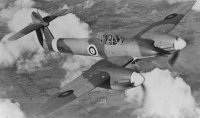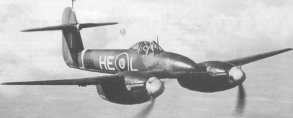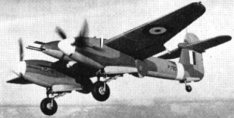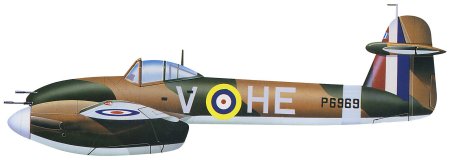
Westland Whirlwind
A sound design let down by unreliable engines, the Whirlwind was a bold attempt to give the RAF a fighter with greater range than single-engined types. With four cannon grouped in the nose, it was able to bring a heavy weight of fire to bear on ground targets. Only two squadrons were issued with Whirlwinds, but the aircraft was greatly appreciated by its pilots. If it had been fitted with better engines, the Whirlwind's career might have taken a different turn.
During the early part of World War II, Britain was very short of twin-engined fighters with the endurance to fly operational sorties across the English Channel and attack targets well inside occupied France. The Westland Whirlwind seemed to be the answer.
Entering service with No. 263 Squadron in December 1941, the Whirlwind was well armed for the ground-attack role and few pilots had ever seen such a concentrated weight of fire from four closely grouped 20 mm (0.79 in) cannon.
The main problem was the engines, which were sometimes quite a liability. The Rolls-Royce Peregrine gave trouble both on the ground and in the air and the decision was taken - after No. 137 Squadrons had also received Whirlwinds in September 1941 - not to develop it further.
Installation of better engines would have meant a major and time-consuming redesign and in view of the steady availability of Beufighters and Mosquitoes, the Whirlwind became one of the war's potential outstanding aircraft that had to be left on the sidelines.
Before it was withdrawn, however, the Whirlwind gave a good account of itself on cross-Channel fighter operations. This attractive twin made short work of German ground targets, E-boats and other enemy shipping. Bombs supplemented the Whirlwind's cannon and for a time, the two squadrons were the scourge of the Germans.
 |
 |
 |
| Carrying bombs on the wing pylons, Whirlwinds made low-level dashes across the Channel before attacking German-held airfields. |
The key to the Whirlwind's impressive performance was its highly streamlined shape. |
With good speed and excellent handling the Whirlwind could match the Bf 109 in a dogfight. They notched up a number of kills in 1942. |
|
Westland Whirlwind (Technical Specification) |
| Role |
Single-seat fighter/fighter-bomber |
| Manufacturer |
Westland |
| Maximum Speed |
580 kmh (360 mph) |
| Maximum Range |
1290 km (800 miles) |
| Ceiling |
9144 meters (30,000 feet) |
Weight
Empty
Maximum Takeoff |
3,770 kg (8,294 lbs)
5,166 kg (11,365 lbs) |
Dimensions
Wingspan
Length
Height
Wing Area |
13.72 meters (45 ft)
9.98 meters (32 ft 9 in)
3.52 meters (11 ft 6 in)
23.22 square meters (250 sq ft) |
| Engines |
Two Rolls-Royce Peregrine liquid-cooled piston engines each providing 660-kW (885-hp) |
| Armament |
Four 20 mm (0.79 in) Hispano cannon in fuselage nose
454 kgs (1,000 lbs) of bombs under wings |
Photo Gallery
Click here to submit your photo
| Have A Passion For Aircraft? |
Subscribe to our 14 series FREE newsletter
delivered weekly on World War 2 Aircraft factfile... |
| NB:- We hate spam as much as you do, so your email address will NEVER be shared with or sold to anyone else. That's a Guarantee. |
|
|





